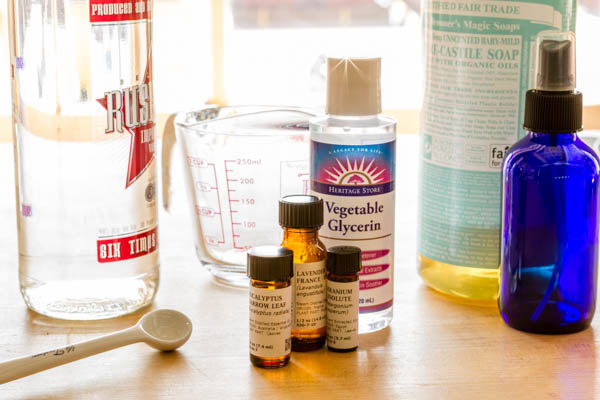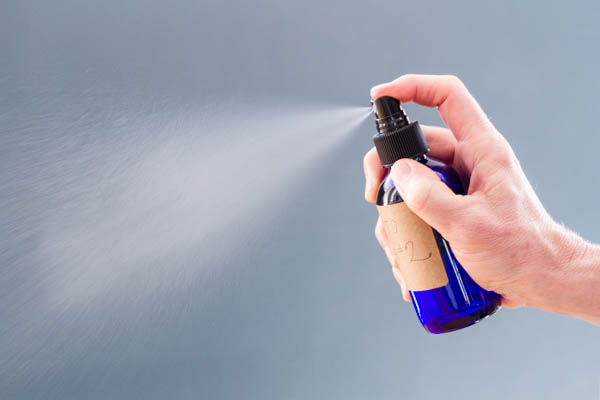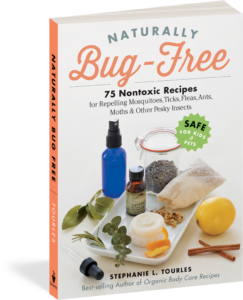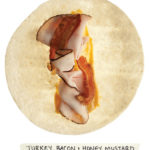Stephanie L. Tourles, author of Naturally Bug-Free, shares two recipes for non-toxic, natural insect repellent you can make at home right now!
Summer is nearly here—my favorite season! It’s a time to celebrate the great outdoors with backyard barbecues, badminton, puttering in the vegetable garden, and sipping evening cocktails on the deck, all while dressed in comfy shorts, T-shirts, and flip flops. Alas, along with these blessedly warm months come the bummers of summer: irritating insects. Mosquitoes, ticks, biting flies, chiggers, midges, and other crawling, flying beasts arrive as if on cue to feast on our exposed skin. But while Mother Nature gave us buzzing, biting insects, she also gave us the means to deal with them.

Photo by Mars Vilaubi
As a writer, licensed esthetician, and herbalist, I frequently hear from people looking for alternatives to commercial insect repellents, which are replete with noxious fumes or chock-full of toxic chemicals. I’m quite sensitive to man-made chemicals myself, especially DEET, which is often the primary bug-repelling ingredient in commercial mosquito repellents. Within minutes of applying one of these commercial brands I develop DEET-induced dermatitis, complete with burning skin and red, itchy spots. Not pretty or comfortable! As a result, I’ve been making my own herb-based repellent products for years using strongly aromatic herbs, essential oils, and other natural ingredients. My homemade formulations smell pleasant, feel great on my skin, and work quite well (though when deer flies and black flies—which, where I live, are jokingly referred to as the “Maine State Bird”—are particularly voracious, I don protective clothing or stay indoors).
I experimented, tested, and perfected dozens of insect-repelling recipes that are quite effective, safe, and non-irritating to most folks (even pets!) and collected them in my latest book, Naturally Bug-Free: 75 Nontoxic Recipes for Repelling Mosquitoes, Ticks, Fleas, Ants, Moths & Other Pesky Insects. So the next time you’re itching to get outside, instead of reaching for chemical-based, potentially irritating repellents, keep pests at bay with natural, nontoxic products that are pleasing to the senses.
The following recipes are two of my favorites. They’re fun and simple to make. And remember: everyone’s body chemistry is unique, so if the first recipe you make doesn’t work as well as you’d like, try another. May you be bugged, boggled, and pestered no more!

Bug Boggle Formula #1
Oil-based: I’ve had this formulation in my herbal remedy recipe box for years. It works wonderfully well with my personal chemistry, and the aroma is quite pleasing, but the bugs apparently don’t like it! This version uses oil as the base ingredient, which leaves the skin feeling velvety soft and nongreasy, but if you’d rather use a lighter formulation, make Formula #2 (recipe follows), which uses alcohol and water as the base ingredients.
Note: Soybean oil is used as a base for its natural bug-repellent properties, but you can substitute your favorite lightweight, organic base oil such as jojoba, sunflower, grapeseed, or almond.
Ingredients
- 15 drops geranium essential oil
- 8 drops cedarwood essential oil
- 8 drops catnip essential oil
- 6 drops eucalyptus essential oil
- 6 drops rosemary essential oil
- 5 drops peppermint essential oil
- ½ cup organic soybean base oil
- 4-ounce spritzer, pump, or squeeze bottle
Directions
- Add the geranium, cedarwood, catnip, eucalyptus, rosemary, and peppermint essential oils directly to the storage bottle, then add the soybean oil. Screw the top on the bottle and shake vigorously to blend. Allow the spray to synergize for 1 hour.
- Store at room temperature, away from heat and light; use within 1 year.
Application
Shake the bottle prior to each use. I like to put a bit of this formula onto my palms, then massage the oil into areas that need bug protection. It is designed to penetrate quickly. If your skin feels greasy after application, you’ve used too much. Reapply as needed.
Bug Boggle Formula #2
Alcohol-and-water-based: This is the same basic formulation as above, but instead of using oil as the base or carrier ingredient, I use a blend of alcohol and water. This combination of ingredients results in a lighter-textured product, which some people prefer, especially in hot, humid climates.
Ingredients
- 15 drops geranium essential oil
- 8 drops cedarwood essential oil
- 8 drops catnip essential oil
- 6 drops eucalyptus essential oil
- 6 drops rosemary essential oil
- 5 drops peppermint essential oil
- ½ teaspoon liquid castile soap, peppermint or eucalyptus scented
- ½ teaspoon vegetable glycerin
- ¼ cup purified water
- ¼ cup unflavored vodka
- 4-ounce spritzer bottle
Directions
- Add the geranium, cedarwood, catnip, eucalyptus, rosemary, and peppermint essential oils directly to the storage bottle, then add the liquid soap, glycerin, water, and vodka. Screw the top on the bottle and shake vigorously to blend. Allow the solution to synergize for 1 hour.
- Store at room temperature, away from heat and light; use within 1 year.
Application
Shake well immediately before use. Spray liberally onto skin as needed—you may need to reapply it every 20 to 30 minutes. May be sprayed on clothing.
RECIPES EXCERPTED FROM NATURALLY BUG-FREE ©2016 BY STEPHANIE L. TOURLES. ALL RIGHTS RESERVED.
 About the Book:
About the Book:
Protect yourself, your children, your pets, and your home from bugs — without using harsh or toxic chemicals! Herbalist Stephanie Tourles offers 75 simple recipes for safe, effective bug repellents you can make at home from all-natural ingredients. For protection from mosquitos, ticks, and other biting insects, there are sprays, balms, body oils, and tinctures, with scents ranging from eucalyptus to floral, lemon, vanilla, and woodsy spice. There are also recipes for pets, such as herbal shampoo, bedding formulas, and flea-and-tick collars and powders. And Tourles includes repellents for the home, such as sachets that repel moths, carpet powders that repel fleas and ants, and essential oil repellents to keep your pantry pest-free. A detailed ingredient dictionary explains the properties of all the herbs, essential oils, and other key ingredients.
Buy the Book
Indiebound | B&N | Amazon | Workman





No Comments